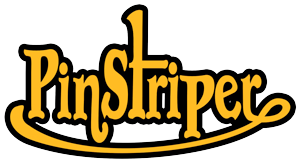Precision Takes Time: Hand-painted pinstriping demands precision and control over every stroke. Achieving consistent line thickness, smooth curves, and intricate details takes time to develop. Just like any skill, practice is crucial for refining these techniques and turning them into second nature.
Muscle Memory and Brush Control: Training your muscles and building muscle memory is a fundamental aspect of mastering pinstriping. The delicate movements required

to create fine lines and intricate patterns need to become ingrained in your hand and wrist. This level of control can only be attained through repetitive practice.
Trial and Error: Pinstriping is as much about learning from mistakes as it is about getting things right. Every stroke teaches you something new, whether it’s about the paint consistency, brush pressure, or hand movement. Patience is vital because errors and setbacks are part of the learning process. They offer insights that contribute to your growth as an artist.
Developing Your Style: The more you practice, the more you’ll discover your unique style within the world of pinstriping. This distinctive flair sets you apart from other artists and makes your work recognizable. Patience is essential as you experiment, adapt, and refine your techniques to develop a style that resonates with you.
Building Confidence: As you gradually improve your skills through practice, your confidence as a pinstriper will naturally grow. Patience plays a pivotal role in this process. It’s common to feel frustrated or discouraged, especially in the early stages. But as you continue to practice and see tangible progress, your confidence will build, making the journey all the more rewarding.
Pinstriping Getting Started
What is a good Pinstriping brush to start with?
Mack Series 10 Blue wrap ferrule. All around versatile brush turns easy and the price is reasonable Find Here
How do I prep my Pinstriping brushes for use?
Wash the brush hair with dishwashing soap to remove the sizing that was used to preserve the brush .Dry by twirling handle with your hands. Gently run fingers thru the hair to dry. Handles can be trimmed to better fit in your palm of your hand. A technique used by many pinstripers is to pull brush upon its tip and into the palm of your hand before you go into a turn. Also trim the tip about 1/32 so it has blunt end. A  blunt end allows you to nicely square the end on your stripes. Why do you want a square end? So that when you join two ends, they look consistent.
blunt end allows you to nicely square the end on your stripes. Why do you want a square end? So that when you join two ends, they look consistent.
(Coming soon Video on how to do this)
What is a good way to practice Pinstriping?
How to practice: Get a piece of tempered glass from a car door, one that is smooth on the
edges, place a design pattern behind the glass (patterns will be available soon) then.
follow the design. Like everything, the more you practice the better you will get.
you need to work on your brush control and breathing.
Muscle Memory and Brush Control: Training your muscles and building muscle memory is a fundamental aspect of mastering pinstriping. The delicate movements required to create fine lines and intricate patterns need to become ingrained in your hand and wrist. This level of control can only be attained through repetitive practice.
What Paint should I use?
Lettering Enamel is pretty much the standard for most pinstripers it’s enamel that flows well for lettering and Pinstriping. (Here) Paint .
Can I clear coat over Lettering Enamels?
Yes. It’s important that your paint is completely dry prior to overcoating. We recommend that you use our Hardener and wait at least 24 hours prior to clearing. Adding up to 20% Hardener, with no other reducers, will allow for overcoating with automotive type urethane clears after 24 hours. Always apply the first two coats of clear very light and dry when clear coating.
